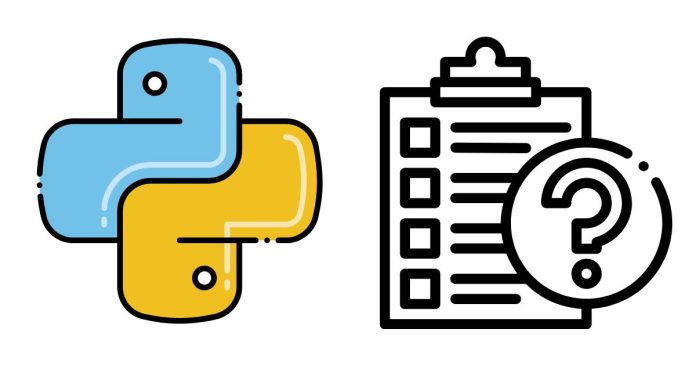Here is a curated list of 50+ Python Interview Questions and Answers for both beginners and experienced developers, categorized by topic:
1. Basic Python Questions
- What is Python?
- Python is a high-level, interpreted, and general-purpose programming language known for its simplicity and readability.
- What are Python’s key features?
- Easy-to-learn, open-source, dynamically typed, interpreted, portable, object-oriented, and supports extensive libraries.
- What is PEP 8?
- PEP 8 is a style guide for Python that ensures readable and consistent code.
- What are Python’s data types?
- Common types include
int,float,str,list,tuple,dict,set, andbool.
- Common types include
- How is Python an interpreted language?
- Python executes code line by line without prior compilation, making it interpreted.
2. Data Structures in Python
- Differentiate between lists and tuples.
- Lists are mutable, whereas tuples are immutable.
- What are Python sets?
- Sets are unordered collections of unique items.
- How do dictionaries work in Python?
- Dictionaries store key-value pairs and provide fast lookups by key.
- Explain list slicing.
- Extract a sublist using the syntax
list[start:end:step].
- Extract a sublist using the syntax
- What is a Python frozenset?
- An immutable version of a set.
3. Functions and Modules
- What are Python functions?
- Reusable blocks of code defined using the
defkeyword.
- Reusable blocks of code defined using the
- What are Python built-in functions?
- Examples:
len(),type(),sum(),min(),max().
- Examples:
- What is a lambda function?
- Anonymous functions created using the
lambdakeyword.
- Anonymous functions created using the
- **What are *args and kwargs?
*args: Pass a variable number of positional arguments.**kwargs: Pass a variable number of keyword arguments.
- Explain Python modules and packages.
- A module is a Python file, and a package is a collection of modules.
4. Object-Oriented Programming (OOP)
- What is OOP in Python?
- A programming paradigm that uses objects and classes to organize code.
- Explain Python classes and objects.
- A class is a blueprint for objects, and objects are instances of classes.
- What are Python class attributes?
- Variables shared across all instances of a class.
- Explain the
selfparameter in Python.- Refers to the instance of the class and is used in instance methods.
- What is inheritance in Python?
- A mechanism to create a new class from an existing class.
- What is polymorphism?
- The ability of different objects to respond to the same method name.
- What are Python decorators?
- Functions that modify the behavior of other functions or methods.
5. Advanced Python Topics
- What is a Python generator?
- A function that returns an iterator using the
yieldkeyword.
- A function that returns an iterator using the
- What are Python iterators?
- Objects with
__iter__()and__next__()methods.
- Objects with
- What is the Global Interpreter Lock (GIL)?
- A mechanism that allows only one thread to execute Python bytecode at a time.
- What is Python’s garbage collection?
- An automatic memory management system that removes unused objects.
- What are Python’s built-in exceptions?
- Examples:
IndexError,KeyError,ValueError,TypeError.
- Examples:
- What is the difference between shallow and deep copy?
- Shallow copy creates a new object but references the original elements, while deep copy copies all objects recursively.
6. Libraries and Frameworks
- What is NumPy?
- A library for numerical computations and array manipulations.
- What is Pandas?
- A library for data manipulation and analysis.
- What is Django?
- A web development framework for building dynamic web applications.
- What is Flask?
- A lightweight web framework for creating simple applications.
- What is TensorFlow?
- A library for machine learning and deep learning tasks.
7. File Handling
- How do you open a file in Python?
- Using the
open()function:open(filename, mode).
- Using the
- What are Python file modes?
- Examples:
r(read),w(write),a(append),rb(read binary).
- Examples:
- How do you handle exceptions in file operations?
- Use
try,except, andfinallyblocks.
- Use
- What is the
withstatement in file handling?- Ensures files are properly closed after operations.
8. Python Frameworks and Databases
- What is SQLAlchemy?
- An ORM tool for database operations in Python.
- What is Pytest?
- A framework for writing simple and scalable test cases.
- How does Python connect to a database?
- Using libraries like
sqlite3orMySQL Connector.
- Using libraries like
9. Miscellaneous
- What is the Python
GIL?- A lock that ensures thread safety in CPython but limits parallel execution.
- What are Python comprehensions?
- Concise ways to create lists, sets, or dictionaries, e.g.,
[x**2 for x in range(5)].
- Concise ways to create lists, sets, or dictionaries, e.g.,
- What is the difference between
isand==?ischecks object identity, while==checks value equality.
- Explain Python’s slicing syntax.
- Access specific parts of sequences like strings or lists using
[start:end:step].
- Access specific parts of sequences like strings or lists using
- What is a metaclass?
- A class that defines the behavior of other classes.
- What is monkey patching in Python?
- Dynamically modifying or extending code at runtime.
- What is the
__init__.pyfile?- Marks a directory as a Python package.
- What are Python’s magic methods?
- Special methods like
__init__,__str__, and__len__.
- Special methods like
- Explain Python threading vs multiprocessing.
- Threading runs threads within a single process; multiprocessing creates separate processes.
- What is Python’s
@staticmethod?- Defines a method that doesn’t need an instance or class reference.
51. Bonus Question
What are Python’s key advantages over other languages?
- Easy syntax, vast libraries, scalability, and extensive community support.
Let me know if you’d like examples for any question! 😊


